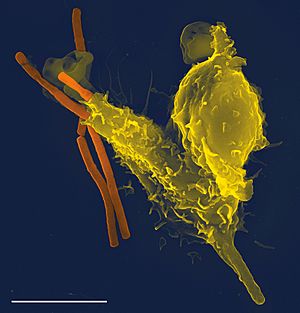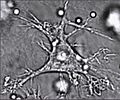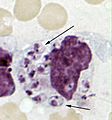Phagocyte facts for kids
Phagocytes are special white blood cells in your body. They protect you by "eating" harmful things like bacteria, dirt, and cells that are dead or dying. They are super important for fighting off infections and helping your body become immune to diseases. Phagocytes are found in all animals, and in animals with backbones (like humans), they are very complex. Just one liter of human blood has about six billion phagocytes!
Contents
What Are Phagocytes?
The word "phagocyte" comes from two Greek words: phagein, which means 'to eat', and kutos, meaning 'hollow vessel' or 'cell'.
A scientist named Ilya Ilyich Mechnikov first saw phagocytes in 1882. Scientists believe that these cells evolved a very long time ago. Even some simple creatures like amoebae act a lot like phagocytes.
Types of Phagocytes
Phagocytes in humans and other animals are called either "professional" or "non-professional." This depends on how good they are at eating things.
Professional Phagocytes
The main professional phagocytes are neutrophils, monocytes, macrophages, dendritic cells, and mast cells. They are called "professional" because they have special parts called receptors on their surface. These receptors can find and grab onto harmful things, like bacteria. Professional phagocytes are very important for fighting infections and cleaning up dead cells.
How Phagocytes Work
When your body has an infection, phagocytes move towards the bacteria. They do this by sensing special chemicals. These chemicals can come from the bacteria themselves or from other phagocytes already fighting the infection. This movement is called chemotaxis.
Eating Germs
When bacteria touch a phagocyte, they stick to the receptors on its surface. Then, the phagocyte "eats" them in a process called phagocytosis. Once the bacteria are inside, some phagocytes use strong chemicals, like oxidants and nitric oxide, to kill the germs.
Showing Off Germ Parts
After eating and killing bacteria, some phagocytes (like macrophages and dendritic cells) can do something called 'antigen presentation'. This means they take tiny pieces of the killed bacteria and move them to their own surface. They then show these pieces to other cells of the immune system.
Some phagocytes travel to your body's lymph nodes. There, they show the bacterial parts to other white blood cells called lymphocytes. This step is very important for your body to learn how to fight off that specific infection in the future, making you immune.
How Germs Avoid Phagocytes
Many bacteria have clever ways to avoid being eaten or killed by phagocytes.
- They might grow in places where phagocytes cannot reach them.
- They can release chemicals that make it hard for phagocytes to get to the infection.
- They can mess with the immune system's signals that tell phagocytes to respond.
- Some bacteria even trick the immune system into thinking they are part of your own body. They do this by covering themselves with natural substances.
Images for kids
-
Micrograph of Gram-stained pus showing Neisseria gonorrhoeae bacteria inside phagocytes and their relative sizes
-
Neutrophils with a segmented nuclei surrounded by erythrocytes, the intra-cellular granules are visible in the cytoplasm (Giemsa stained)
-
Rickettsia are small bacteria—here stained red—that grow in the cytoplasm of non-professional phagocytes.
See also
 In Spanish: Fagocito para niños
In Spanish: Fagocito para niños















